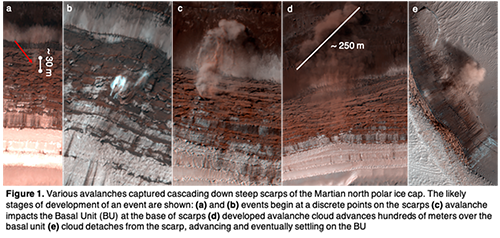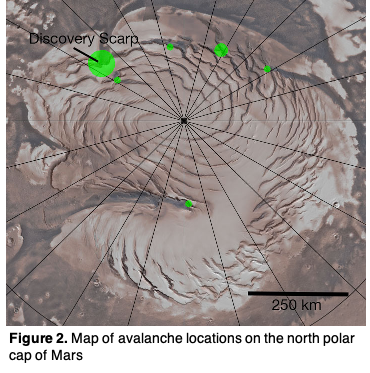Avalanches of the Martian north polar cap
- 1Universität Bern, Physikalisches Institut, Bern, Switzerland (patricio.becerra@space.unibe.ch)
- 2Lunar and Planetary Laboratory, University of Arizona, Tucson, AZ, USA
- 3Laboratoire de Planétologie et Géodynamique, CNRS UMR6112, Université de Nantes, France
1. Introduction
In 2008, the High Resolution Imaging Science Experiment (HiRISE) on board NASA’s MRO fortuitously captured several discrete clouds of material (Fig.1) in the process of cascading down a steep scarp of the water-ice-rich north polar layered deposits (NPLD). The events were only seen during a period of ~4 weeks, near the onset of northern spring, when the seasonal cover of CO2 is beginning to sublimate from the north polar regions. Russell et al. [1] analyzed the morphology of the clouds, inferring that the particles involved were mechanically analogous to terrestrial “dry, loose snow or dust”, making the events similar to terrestrial “powder avalanches” [2]. HiRISE confirmed the seasonality of these avalanches the following spring, and has been monitoring them (Fig.2) for a total of 7 Mars Years (MY29–MY35). We will present observations from this monitoring. We seek to: (1) quantify the frequency of these events (2) quantify their effect on the mass balance of the NPLD (especially with respect to competing processes such as viscous deformation and other mass-wasting events [3-5], and (3) investigate possible trigger mechanisms.
2. Observations
The avalanches often appear as dense clouds of reddish, air-lofted material moving down scarps of the NPLD margins. The scarps are steep (>50º) and appear fractured (Fig.1), and the clouds themselves range in extent from just a few tens of meters to over 200 m. Observations of many avalanche events at different stages allow us to deduce the course of a typical event. Avalanches start at a discrete point on the steep face and remain small and optically thick as they descend (Fig.1a,b). Upon reaching the basal unit they spread outward at speeds of several m/s (measured from color fringing in HiRISE images [1]), become optically thinner, and develop a more diffuse boundary (Fig1.c,d). The avalanches then transition to near-stationary clouds close to, but detached from the scarp, which presumably slowly settle onto the exposed basal unit (Fig.1e).
A total of 57 events have been captured in action on the so-called “Discovery Scarp” (Fig.2) since the first five events were captured here in a single HiRISE image. On average, 8 events are captured on this scarp per year, and they tend to occur on its steepest sections (50–70º), and preferentially on SW-facing scarps. Figure 2 shows the location of the Discovery Scarp and all other scarps along the NPLD margins where avalanches have been observed. An average of 20 new events are observed every year.
Avalanches have only been observed to occur between Ls 5º and 70º, and thus are an exclusively “springtime” event. This time of year coincides with both the sublimation of seasonal CO2 ice over the north polar region, and with a peak in subsurface compressional stresses in the scarp walls, as shown by [6].
3. Trigger mechanisms
In accordance with the seasonality of the avalanches, trigger mechanisms to consider are (1) sublimation-driven collapse of sections of the scarp wall (material in the avalanches would most likely be a combination of CO2 and surface dust), and (2) thermal stress-driven collapse, similar to exfoliation of granitic domes on Earth [6] (material would mostly be pulverized dusty water ice, i.e. the material that makes up NPLD beds).
To examine the first mechanism, we acquired HiRISE images early in the season, before the events occurred. Images of the discovery scarp at Ls 350º (Fig.3a) and Ls 1º appear to show that the CO2 has already sublimated from the steepest parts of the wall by this time. However, CRISM spectra of this location (Fig.3b,c) show absorption bands diagnostic of CO2 until after Ls 50º. Though the bands are weak, their presence suggests CO2 persists until this time. We also used a 1D thermal balance model [7] to calculate the amount of CO2 frost that accumulates on a steep surface throughout the year. With conservative estimates for thermal properties (i.e., assumed an exposed wall of water ice), model results show that on a 50º SW-facing slope, all CO2 frost has sublimated by Ls 10º, matching HiRISE observations but contradicting CRISM. This thermal model is extremely sensitive to dust cover on the scarp wall however, and a few cm of dust can accumulate, and maintain wintertime CO2. It is also possible that the steepness of the scarp makes it difficult to isolate in the CRISM data, and that the absorption bands correspond to influence from adjacent, flatter terrains.
4. Results and Future Work
Our study shows that north polar cap avalanches occur frequently on steep, marginal scarps of the NPLD, and likely have a substantial effect in eroding the NPLD. There are contradicting observations of CO2 frost on the steepest areas of the scarps, which we will further investigate with CRISM observations at high-roll angles that view the scarp more head-on. Even if CO2 is present in small amounts on the scarps early in the year, we have found that it is the fractured scarps that show a much higher frequency of avalanches than those that show little to no fracturing. Thus, although CO2 may be present in the clouds mixed with the avalanche material as it moves over the basal unit, a more likely trigger seems to be the springtime peak in compressional stresses that fractures the scarps [6]. In the future, we will quantify the mass wasted by the events with flow models used for terrestrial processes, and further investigate the triggers with improved detail in the thermal and stress models.



References
[1] Russell et al. (2008) GRL. 35, L23204. [2] McClung and Schaerer (2006), Mountaineers, Seattle Wash. [3] Sori, et al., GRL, 43. [4] Herkenhoff et al. (2020) 7th ICMPSE [5] Fanara et al. 2020, Icarus [6] Byrne et al. (2016), 6th ICMPSE [7] Dundas and Byrne (2010) Icarus 206, 716.
How to cite: Becerra, P., Herny, C., Valantinas, A., Byrne, S., Thomas, N., and Conway, S.: Avalanches of the Martian north polar cap, Europlanet Science Congress 2020, online, 21 Sep–9 Oct 2020, EPSC2020-1093, https://doi.org/10.5194/epsc2020-1093, 2020.

